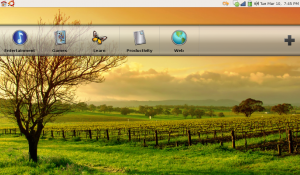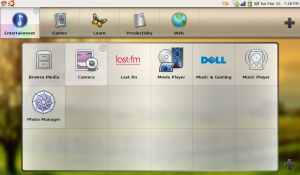Having discussed the Dell Mini 9 hardware, it seems only fair to devote a few paragraphs to its software. You may recall that I ordered the Ubuntu version of the netbook, which ships with a Dell-modified version of Ubuntu 8.04. This version is over a year old now – a long time in the Linux desktop world – but it is an “LTS” or “Long Term Support” release. In short that means that updates will be available for three years, rather than the 18 months of a non-LTS release. During this time there will be another LTS release, giving users (or in this case, Dell) the option to ride the cutting edge with non-LTS updates every 6 months, or just update from LTS to LTS every couple of years.
Dell has gone for the latter. In other words, there’s no Dell version of Ubuntu 8.10 or Ubuntu 9.04. You either stick with 8.04 until the next LTS release (assuming Dell make that available on their servers), or you forego the Dell-modified version of Ubuntu entirely and install something else, whether it’s non-LTS Ubuntu, a different Linux distribution, or even a different operating system entirely, such as Windows or BSD.
What’s Good About Dell’s Ubuntu
A lot of things, really. For a start it builds on the stable base of Ubuntu 8.04, Hardy Heron – arguably one of the better Ubuntu releases. It ships with some licensed codecs for MP3 playback and so on, as well as some common-but-non-Free applications (Flash, Acrobat Reader), avoiding some of the common pitfalls for users who are new to Linux and don’t know really appreciate why their MP3s won’t play, or their Flash sites don’t work. Perhaps the best bit, in my opinion, is Dell’s take on a netbook launcher.
What’s a netbook launcher? It’s a bit of software that comes by default with just about any netbook which lets you launch applications using big icons, instead of by trying to navigate a small menu. It’s intended as a way to simplify access to your most commonly used applications – to make it quick and easy to launch a web browser and the couple of other applications (or games) that you most frequently use. They usually have a mechanism for adding new launchers, or moving them to a “favourites” screen of some sort, so that you can control which applications you have easy access to, and which require a few extra clicks.
In Dell’s case you can add and remove launchers, but there’s no concept of a favourites screen. Initially you are presented with your desktop background (or Dell’s quite tasteful default), overlaid with a translucent strip of launcher categories. Click on a category, and the launchers fade in, accompanied by a zoom-and-blur effect on the desktop image. The whole thing is quite slick, and ensures that any launcher is available via two clicks on nice big icons.


If you do need to access an app that hasn’t got a launcher, there’s also a top panel with an Ubuntu menu that you can select from if your fine-motor skills are up to it (although for some reason it doesn’t include all the applications – The Gimp is missing, despite being installed on the machine). From this menu you can also launch an application to switch to a “normal” Ubuntu desktop – complete with both top and bottom panels, if you prefer not to use the netbook launcher. Oddly enough, switching to the normal desktop mode also reinstated The Gimp in the menu.
Finally, Dell have done the right thing with the window manager. They use a WM called “Maximus” which is designed largely for use with netbooks and other small-screen devices. By default it’s configured so that pressing CTRL-ALT-F will fullscreen the current application by removing the window’s title bar and expanding the content to fill the whole screen (over the top of the panels). This is great for playing “The Battle For Wesnoth“, though apps that have their own idea of how to fullscreen usually do a better job of it – such as when pressing F11 (or FUNCTION-Z on the Dell Mini) in Firefox.
What’s Bad About Dell’s Ubuntu
Just one thing really: updates. Ubuntu 8.04 is over a year old now, and there have been two non-LTS releases since then. If your requirements of a netbook are low then this may well be sufficient, but I prefer to use the most recent Ubuntu release on my computers, and don’t really want to deal with one machine that’s on an older version. Unfortunately Dell don’t offer any more recent versions in their repositories, so if you want a newer Ubuntu, you have to install it yourself.
That brings me onto the next instalment of this series: the Ubuntu Netbook Remix…
Comment (1)
Comments are closed.